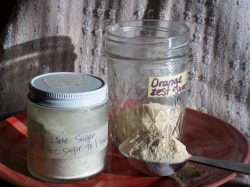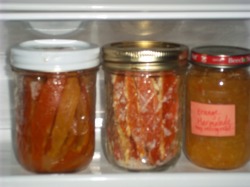

How is your 3-month supply coming? I know some of you are past that; another post lists quantities for a year’s supply. Once you have 3 months, remember it counts towards your full year, and long-term storage foods are the cheapest you can eat. It will cost you less to get that remaining 9 months than it did to get the 3 months’ worth.
Now for this week’s information, the recipe is for something simple to do with all those wonderful oranges that are in season right now.
President Benson said, “There are blessings in being close to the soil, in raising your own food even if it is only a garden in your yard and a fruit tree or two. Those families will be fortunate who, in the last days, have an adequate supply of food because of their foresight and ability to produce their own.” –October 1980 General Conference
Between fall harvest and early spring is a perfect time to plan your garden. A lot of stores already have their seeds in stock by February, and many seed companies have discount coupons to their sites online.
I suggest starting small. If you’ve never grown anything, start with just 1-4 types of vegetables your first year. Some easy ones include lettuce, peas, radishes, beets, green beans, tomatoes, and pumpkins. If you don’t have a garden spot, try growing them in a flower bed. Or just tear out some grass. You’ll water the same amount, but get food out of the deal.
The best resource around for Utah is the USU Extension office. Their website is http://extension.usu.edu/
For which varieties are known to produce well here, look at "Recommended Vegetable Varieties", http://extension.usu.edu/files/publications/factsheet/pub__5657148.pdf
For more gardening info, go to the Horticulture Fact Sheets (shortcut is http://extension.usu.edu/htm/publications/by=category/category=43 )There is all the other info you'd want on growing any particular vegetable- when to plant, how much to fertilize, how much food you can expect from each plant, etc.
For when to put your seeds in the ground, here's "Suggested Vegetable Planting Dates for the Wasatch Front", http://extension.usu.edu/files/publications/publication/Horticulture_Garden_2009-01pr.pdf Nothing goes in the ground yet, unless you have a greenhouse.
I highly recommend testing your soil. Last I checked, it was $15 per sample, going through the Extension Office. The linked article was from 1990, that's why it says the test is $10. They suggest testing yearly, but one year’s test will at least tell you what your soil needs to start with. This will save you headaches, using the wrong fertilizer, or too much/not enough fertilizer. Definitely worth it. You'll earn the cost of the test back in fertilizer! The article on this link is Testing Your Soil: http://extension.usu.edu/files/publications/factsheet/HG_H_05.pdf Typically I do 3-4 samples in my yard- front, back, side, and garden location. Yes, there have ALWAYS been significant differences.
One more good article to read before you start; "Preparing and Improving Garden Soil" http://extension.usu.edu/files/publications/factsheet/pub__8066784.pdf
For when to put your seeds in the ground, here's "Suggested Vegetable Planting Dates for the Wasatch Front", http://extension.usu.edu/files/publications/publication/Horticulture_Garden_2009-01pr.pdf
Hopefully this wasn't too big of a load to dump on you- just read what you can get to. The above is good, basic, start-from-scratch information. Do you have more specific questions? The USU extension site will probably have an answer...
Good seed sources: http://miniag.com/?page_id=316 (family business in Colorado, most seeds are $1 per packet, which is very good) http://www.seedstrust.com (specializing in non-hybrid, high-elevation- short season-, and heirloom seeds- with the best selection of tomatoes I’ve ever seen!), http://gurneys.com (they also have a coupon for $25 off a $50 order. Most of my fruit trees have come from there), most grocery stores, Walmart, Lowe’s, Home Depot, local nurseries. IFA in Riverton (1926 W 12600 S) has bulk seeds- peas, corn, green beans. I got a half pound of peas for the same price as a less-than-one-ounce packet.
It turns out that orange (or any citrus) peel is full of nutrition. According to Answers.com, “One may be surprised to find that there is 2,000% of the daily recommended value of vitamin C, 100% of the daily recommended value of Calcium, and 90% of the daily recommended value of vitamin A in any type of orange peel.” I certainly was surprised! The pith (white part, bitter) is also very high in pectin, which is why marmalade thickens so well. Pectin is a great fiber for your body and is a prebiotic. Prebiotics help the probiotics live happily inside you. Compounds in citrus peel has shown in studies to be as effective as statin drugs for lowering LDL cholesterol. Who knew? All this means that if you’ve been saving and storing your orange peel (dried and ground up, or otherwise), you’ve been stashing away a multivitamin!
Homemade Orange Flavoring- preserving orange zest; this works for any citrus as well.
Wash and dry 3-4 oranges. (or as many as you like)
Use a vegetable peeler to peel all the orange off the outside. (eat the oranges!) Spread the peels on a plate, and let dry out for a couple days, until they’re thoroughly dry. Drop them in a blender or food processor, add 1 Tbsp sugar for each orange you had, and run on high until peel is very finely chopped. Store in an old spice jar, baby food jar, or a small jelly jar. Label it. 2 Tablespoons gives you the zest of one orange, enough to flavor a batch of about anything; muffins, cakes, cookies, pancakes, whatever. Use it in place of part of the recipe’s sugar. Also good as part of a spice rub for meats.
You don’t really need to add sugar, but it seems to help the zest hold its flavor longer, and makes it easier to have enough in the blender for it to chop well. If you’re not using sugar, 1 Tbsp. is the zest of one orange.
Another way to preserve oranges is
Easy Orange Marmalade
1 orange, washed well
Sugar or honey
Cut the orange into quarters, and put it, peel and all, in a blender or food processor. Turn on and let it chop as fine or coarse as you like your marmalade. Look at how much puree you have, and use that same amount of sugar or honey. Put the puree and sugar in a saucepan and heat on high until it boils. Simmer for 5 minutes, until everything is translucent. You’re done. Makes 1- 1 ½ cups, depending on your orange. Or make a big batch, this will take more like 10 minutes of simmering. Pour into jars, seal if you want to store it for a year or more. I’ve kept it in unsealed jars in the refrigerator for 9-10 months before. They might have lasted longer, but we ate them first.
Do you ever have oranges start to shrivel and dry out? Turn them into marmalade, even if the peels are hard as leather. It’s also delicious to make lemon or lime marmalade, or a mixture. The lemon is my favorite, especially using just a bit of salt and vanilla – 1/8 tsp. salt, ¼ tsp. vanilla per cup of puree.
You can use marmalade as the sweetener in recipes; a cup of it has about ¾ c. sugar. I love it in muffins.
Candied Orange Peels (short version instructions): save peels from 5-8 oranges, boil them in 3 changes of water, drain, cut in strips with scissors, simmer til translucent in 2 c. sugar and ½ water. Roll in extra sugar while still warm.
I usually keep these in a container in the fridge, but I've sealed them in jars (10 minutes in a boiling-water bath) when still hot, and also dry-sealed them after letting them thoroughly dry out on top of the cupboards for a week or two.
 RSS Feed
RSS Feed